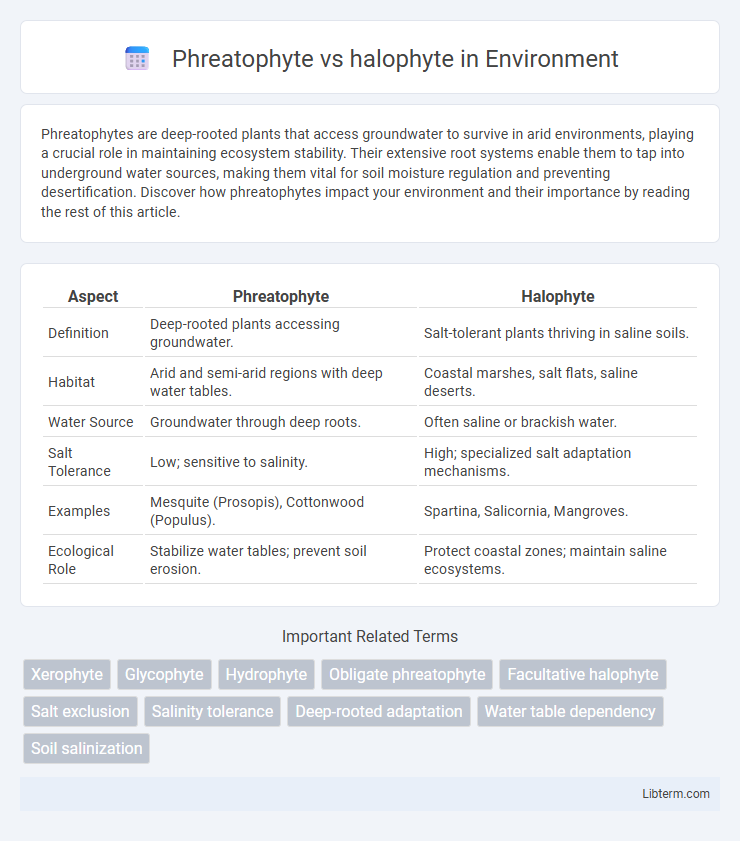Phreatophytes are deep-rooted plants that access groundwater to survive in arid environments, playing a crucial role in maintaining ecosystem stability. Their extensive root systems enable them to tap into underground water sources, making them vital for soil moisture regulation and preventing desertification. Discover how phreatophytes impact your environment and their importance by reading the rest of this article.
Table of Comparison
| Aspect | Phreatophyte | Halophyte |
|---|---|---|
| Definition | Deep-rooted plants accessing groundwater. | Salt-tolerant plants thriving in saline soils. |
| Habitat | Arid and semi-arid regions with deep water tables. | Coastal marshes, salt flats, saline deserts. |
| Water Source | Groundwater through deep roots. | Often saline or brackish water. |
| Salt Tolerance | Low; sensitive to salinity. | High; specialized salt adaptation mechanisms. |
| Examples | Mesquite (Prosopis), Cottonwood (Populus). | Spartina, Salicornia, Mangroves. |
| Ecological Role | Stabilize water tables; prevent soil erosion. | Protect coastal zones; maintain saline ecosystems. |
Introduction to Phreatophytes and Halophytes
Phreatophytes are deep-rooted plants that access groundwater through extensive root systems, enabling survival in arid environments by tapping into subsurface moisture. Halophytes thrive in saline soils or coastal environments by adapting physiologically to salt stress, often through salt excretion or sequestration mechanisms. Both plant types exhibit specialized adaptations critical for survival in challenging habitats, with phreatophytes primarily managing water scarcity and halophytes coping with high salinity.
Defining Phreatophytes: Characteristics and Adaptations
Phreatophytes are deep-rooted plants adapted to access groundwater by extending their roots into saturated soil layers, allowing survival in arid and semi-arid environments. These plants exhibit specialized traits such as extensive root systems and drought resistance to exploit stable water sources below the surface. Unlike halophytes, which tolerate saline conditions, phreatophytes primarily focus on water acquisition from deep aquifers rather than salt tolerance.
Defining Halophytes: Characteristics and Adaptations
Halophytes are plants adapted to thrive in saline environments such as salt marshes, coastal regions, and saline deserts, exhibiting specialized salt tolerance mechanisms. These plants often possess salt glands or bladders for excreting excess salt, succulent leaves to store water, and deep root systems to access freshwater below the saline surface. Unlike phreatophytes, which primarily focus on accessing groundwater, halophytes have developed physiological and morphological adaptations to survive high salinity and osmotic stress.
Habitat Comparison: Where Phreatophytes and Halophytes Thrive
Phreatophytes thrive in environments with deep water tables such as riparian zones and arid regions where roots access groundwater, enabling survival in drought-prone habitats. Halophytes grow in saline environments like salt marshes, coastal dunes, and saline deserts, specialized to tolerate high salt concentrations in soil and water. Both plant types occupy extreme habitats but differ primarily in water availability and salinity levels.
Water Source Preferences: Deep Groundwater vs Saline Environments
Phreatophytes derive water primarily from deep groundwater sources, utilizing extensive root systems to access moisture far below the soil surface. In contrast, halophytes thrive in saline environments, adapting to high salt concentrations by either excluding, excreting, or sequestering salt to maintain hydration. These distinct water source preferences highlight phreatophytes' reliance on freshwater reservoirs versus halophytes' specialized mechanisms for salt tolerance and water uptake in coastal or inland salt-affected soils.
Physiological Adaptations for Survival
Phreatophytes exhibit deep root systems that access groundwater, enabling survival in arid environments by maintaining hydration and nutrient uptake despite surface dryness. Halophytes possess specialized salt glands and succulence to manage high salinity, excreting excess salt and storing water in tissues to prevent desiccation. These physiological adaptations optimize water balance and ion regulation, ensuring persistence in challenging ecological niches.
Ecological Roles and Environmental Importance
Phreatophytes play a crucial role in groundwater regulation by accessing deep water tables, thus helping to stabilize hydrological cycles in arid and semi-arid ecosystems. Halophytes contribute significantly to soil salinity management and coastal ecosystem resilience by thriving in high-salinity environments and preventing salt accumulation. Both plant types support biodiversity by providing specialized habitats and food sources for a variety of wildlife adapted to extreme environmental conditions.
Key Examples of Phreatophyte and Halophyte Species
Key examples of phreatophyte species include mesquite (Prosopis spp.), willows (Salix spp.), and cottonwood (Populus spp.), which rely on groundwater for survival in arid environments. Halophyte species such as Spartina alterniflora (smooth cordgrass), Salicornia (glasswort), and Atriplex (saltbush) thrive in saline soils by employing salt-exclusion or salt-secretion mechanisms. Both groups demonstrate specialized adaptations to extreme environmental conditions, with phreatophytes accessing deep water tables and halophytes managing high salinity.
Challenges and Threats Facing Both Plant Types
Phreatophytes face challenges related to groundwater depletion and habitat loss due to excessive water extraction and land development, threatening their survival in arid and semi-arid environments. Halophytes struggle with increased soil salinization driven by climate change and agricultural practices, which can exceed their salt tolerance limits and reduce growth and reproduction. Both plant types are vulnerable to environmental changes that disrupt their specialized adaptations, impacting ecosystems dependent on these species for stability and biodiversity.
Conclusion: Phreatophytes vs Halophytes – Key Differences and Similarities
Phreatophytes and halophytes are both specialized plants adapted to challenging environments, with phreatophytes primarily relying on deep groundwater access and halophytes thriving in saline soils. Phreatophytes excel in arid or semi-arid regions by developing extensive root systems that tap into subsurface water, while halophytes possess biochemical mechanisms like salt excretion and succulence to tolerate high salinity. Understanding these adaptations highlights their ecological roles in water management and soil salinity mitigation.
Phreatophyte Infographic

 libterm.com
libterm.com